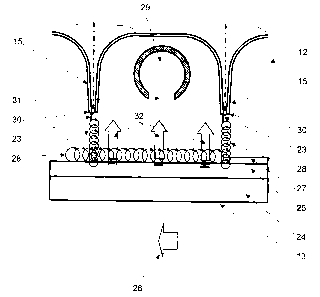Une partie des informations de ce site Web a été fournie par des sources externes. Le gouvernement du Canada n'assume aucune responsabilité concernant la précision, l'actualité ou la fiabilité des informations fournies par les sources externes. Les utilisateurs qui désirent employer cette information devraient consulter directement la source des informations. Le contenu fourni par les sources externes n'est pas assujetti aux exigences sur les langues officielles, la protection des renseignements personnels et l'accessibilité.
L'apparition de différences dans le texte et l'image des Revendications et de l'Abrégé dépend du moment auquel le document est publié. Les textes des Revendications et de l'Abrégé sont affichés :
| (12) Demande de brevet: | (11) CA 2442663 |
|---|---|
| (54) Titre français: | DISPOSITIF DE SECHAGE POUR MATERIEL IMPRIME |
| (54) Titre anglais: | DRYING DEVICE FOR PRINTED MATERIAL |
| Statut: | Réputée abandonnée et au-delà du délai pour le rétablissement - en attente de la réponse à l’avis de communication rejetée |
| (51) Classification internationale des brevets (CIB): |
|
|---|---|
| (72) Inventeurs : |
|
| (73) Titulaires : |
|
| (71) Demandeurs : |
|
| (74) Agent: | SMART & BIGGAR LP |
| (74) Co-agent: | |
| (45) Délivré: | |
| (22) Date de dépôt: | 2003-09-25 |
| (41) Mise à la disponibilité du public: | 2004-04-01 |
| Requête d'examen: | 2003-09-25 |
| Licence disponible: | S.O. |
| Cédé au domaine public: | S.O. |
| (25) Langue des documents déposés: | Anglais |
| Traité de coopération en matière de brevets (PCT): | Non |
|---|
| (30) Données de priorité de la demande: | ||||||
|---|---|---|---|---|---|---|
|
The drying disposal for a printed material (13), in strip or sheet,
uses a drying fluid propelled in the direction of the printed material (13)
through
nozzles (15), each of them equipped with one blowing opening (30) and meant
to blow a drying fluid or medium warmed by heating elements. Nozzles (15) are
arranged in an enclosed space of a drying device (12). The drying fluid or
medium presents, near the printed material (13), a turbulent flux that is
immediately produced at the exit of the blowing openings (30) of nozzles (15)
through transformation means (23) of a laminar flux in a turbulent flux. The
drying fluid or medium is extracted from the enclosed space of the drying
device (12) by the mean of an exhaust pipe (29) located between two
successive nozzles (15), preferably, but not compulsorily, equidistant to each
of
these aforesaid nozzles (15).
Note : Les revendications sont présentées dans la langue officielle dans laquelle elles ont été soumises.
Note : Les descriptions sont présentées dans la langue officielle dans laquelle elles ont été soumises.

2024-08-01 : Dans le cadre de la transition vers les Brevets de nouvelle génération (BNG), la base de données sur les brevets canadiens (BDBC) contient désormais un Historique d'événement plus détaillé, qui reproduit le Journal des événements de notre nouvelle solution interne.
Veuillez noter que les événements débutant par « Inactive : » se réfèrent à des événements qui ne sont plus utilisés dans notre nouvelle solution interne.
Pour une meilleure compréhension de l'état de la demande ou brevet qui figure sur cette page, la rubrique Mise en garde , et les descriptions de Brevet , Historique d'événement , Taxes périodiques et Historique des paiements devraient être consultées.
| Description | Date |
|---|---|
| Inactive : Morte - Aucune rép. dem. par.30(2) Règles | 2007-07-24 |
| Demande non rétablie avant l'échéance | 2007-07-24 |
| Inactive : Abandon. - Aucune rép dem par.30(2) Règles | 2006-07-24 |
| Inactive : CIB de MCD | 2006-03-12 |
| Inactive : CIB de MCD | 2006-03-12 |
| Inactive : Dem. de l'examinateur par.30(2) Règles | 2006-01-24 |
| Demande publiée (accessible au public) | 2004-04-01 |
| Inactive : Page couverture publiée | 2004-03-31 |
| Inactive : CIB en 1re position | 2003-11-06 |
| Lettre envoyée | 2003-10-27 |
| Inactive : Certificat de dépôt - RE (Anglais) | 2003-10-27 |
| Lettre envoyée | 2003-10-22 |
| Demande reçue - nationale ordinaire | 2003-10-22 |
| Toutes les exigences pour l'examen - jugée conforme | 2003-09-25 |
| Exigences pour une requête d'examen - jugée conforme | 2003-09-25 |
Il n'y a pas d'historique d'abandonnement
Le dernier paiement a été reçu le 2006-06-06
Avis : Si le paiement en totalité n'a pas été reçu au plus tard à la date indiquée, une taxe supplémentaire peut être imposée, soit une des taxes suivantes :
Les taxes sur les brevets sont ajustées au 1er janvier de chaque année. Les montants ci-dessus sont les montants actuels s'ils sont reçus au plus tard le 31 décembre de l'année en cours.
Veuillez vous référer à la page web des
taxes sur les brevets
de l'OPIC pour voir tous les montants actuels des taxes.
| Type de taxes | Anniversaire | Échéance | Date payée |
|---|---|---|---|
| Requête d'examen - générale | 2003-09-25 | ||
| Taxe pour le dépôt - générale | 2003-09-25 | ||
| Enregistrement d'un document | 2003-09-25 | ||
| TM (demande, 2e anniv.) - générale | 02 | 2005-09-26 | 2005-04-08 |
| TM (demande, 3e anniv.) - générale | 03 | 2006-09-25 | 2006-06-06 |
Les titulaires actuels et antérieures au dossier sont affichés en ordre alphabétique.
| Titulaires actuels au dossier |
|---|
| BOBST S.A. |
| Titulaires antérieures au dossier |
|---|
| PETER A. MONKEWITZ |
| TRONG-VIEN TRUONG |